There is no stopping Bayern Munich under Hans-Dieter Flick. The Bavarians once again proved that against Barcelona on Friday night in the UEFA Champions League quarter-final fixture.
Bayern Munich looked like a fading force under Niko Kovač but under Hansi Flick went through a complete overhaul, whereas Barcelona’s misery does not look to go away anytime soon. The recent performances of both the teams indicated towards a Bayern Munich victory but no one in their million dreams ever dreamt of an 8-2 scoreline.
In this tactical analysis, we will decipher the reason behind Barcelona’s debacle and the tactics and intricacies of both the managers.
Line-ups
Hans-Dieter Flick opted to go with the same formation and line-up that the gaffer fielded in the 2nd leg of round of 16 against Chelsea. Manuel Neuer manned the goal-post, Alphonso Davies and Joshua Kimmich assumed their usual positions either side of David Alaba and Jérôme Boateng. Thiago Alcântara and Leon Goretzka acted as the double pivot. Thomas Müller, the Raumduter started in the hole behind Robert Lewandowski and on either side of the German positioned the prolific Serge Gnabry and the experienced Ivan Perišić.
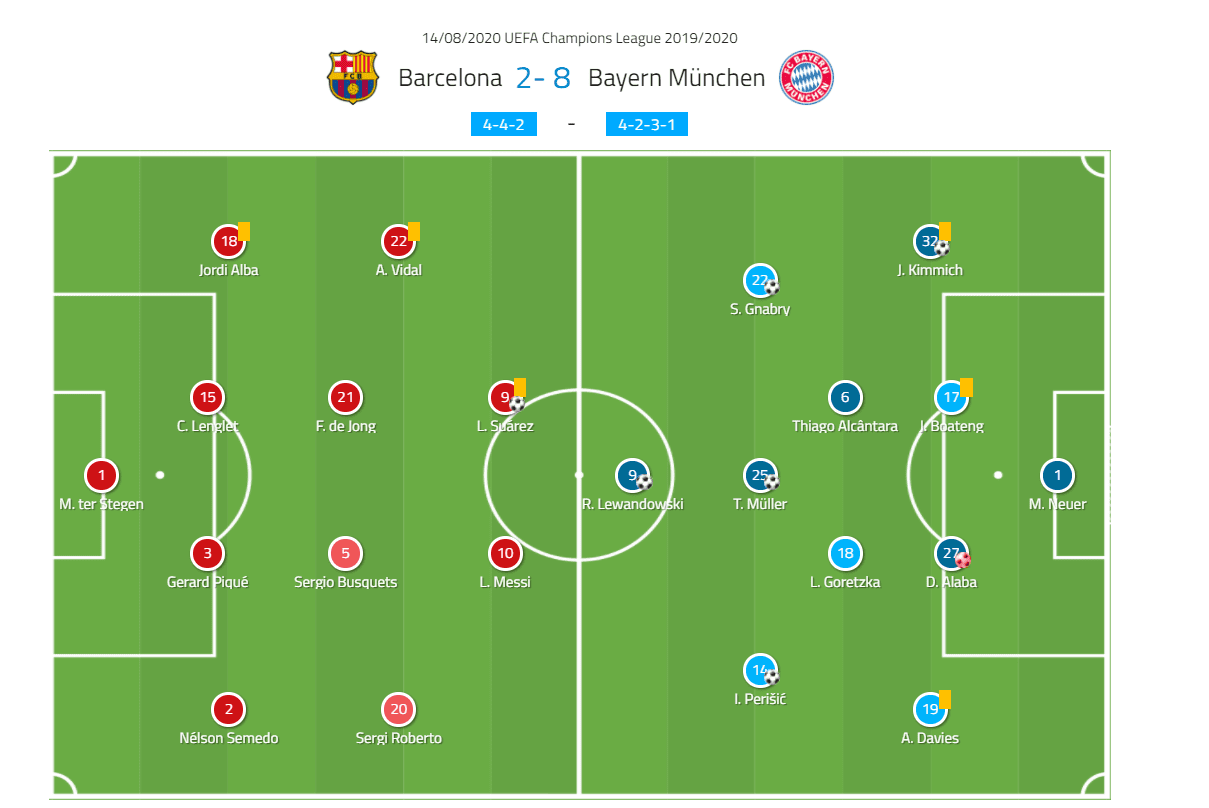
Quique Setién had different intentions. The Spaniard shuffled his line-up as well as altered the formation that led them to the quarter-final. The 4-3-3 changed to flat 4-4-2 and Sergio Busquets and Arturo Vidal were called up to the starting line-up in place of Ivan Rakitić and Antoine Griezmann.
Bayern takes advantage of Barcelona’s vapid pressing
Out of possession, Barcelona defended in a flat 4-4-2 block, with Messi and Suárez leading the press. The first line of press was almost non-existent with Messi and Suárez ineffective and hardly putting any pressure on the ball-carrier. Even the central midfielders failed to control the space in the midfield, as can be seen in the image below, Busquets and de Jong were poorly staggered.

With no pressure on Alaba, poorly staggered midfield, and the huge distance between the 2nd line and the last line of defence, the Austrian played a pass beyond the second line of defence.

Bayern, in possession, mainly played in a three-man backline, with Thiago dropping deep and Goretzka in between Barcelona’s first and second line of defence or in between the second and last line of defence or with the second line, depending upon the dynamics of the game. The four attacking players overloaded Blaugrana’s last line of defence and dropped in between the lines whenever intended.
Again, with no pressure on the ball from Barcelona’s front two, left Boateng to operate in a huge space and with a lot of time. He has two easy options in the form of the dropping Lewandowski and Davies who is providing width on the left flank.

Boateng opts for the second option. Barcelona preferring to stay compact and protecting the central corridors (central channel and half spaces) left too much space on the flanks. Boateng’s switch to Davies created a 2 on 1 situation for the right-back Semedo.

With Bayern constantly opting for the Boateng-Davies combination in the initial minutes, Semedo started to drift a bit wide to prevent the switch in play to Davies. It created a 4 v 3 situation with Blaugrana’s last line of defence and Kimmich wide open on the right-flank could have caused Barcelona serious damage. Thiago opted for the Kimmich route. The right-back’s cross even found Muller in the 18-yard box but Bayern failed to score from this play.

Bayern did not have to work hard to build-up, Barcelona’s flat 4-4-2 structure was overwhelmingly flawed. In the image below, Busquets preferred to move a bit up and follow Thiago with Vidal pressing Kimmich. It left Barça too poorly staggered in the midfield region, the region which Barça intended to protect. It left Goretzka unmarked and Muller and Lewandowski created a 2 v 1 situation on de Jong. Kimmich found Muller who switched the flank. Fortunately for Barcelona, they did not concede from this specific play.

With Bayern realising the space opened for them in the central corridors itself, the Bavarians started to build-up focussing the central corridors.
Giving Thiago time and space on the ball is a recipe for disaster. In the image below, Goretzka pushed up and positioned himself in between the lines which created a 5 v 4 situation with Barcelona defenders and 2 v 1 on Lenglet. Again, with Busquets and de Jong poorly staggered, Thiago found an easy pass to Goretzka who provided the assist for Gnabry.

Bayern is tremendous in creating space for one another. One creates space and the other exploits the space.
The situation below demonstrates how Müller and Lewandowski create space for Goretzka. Muller drags out Lenglet from his position and passes the ball back to Kimmich. Lewandowski realising the space he could create for the marauding Goretzka, lures Pique out from his position. With Vidal caught ball-watching, the German midfielder makes a run behind his back. Fortunately for Barcelona, Goretzka hit it way above the post.

Bayern’s initial pressing predicament
Bayern and pressing quandary sound odd but Bayern did struggle with their pressing in the initial 15 minutes or so.
Bayern kept a very high line and kept the distance between the lines a bare minimum. The Bavarians looked to keep the central corridors compact and a midfielder or sometimes both the midfielders positioned themselves between the second and last lines of defence with the thought of preventing the Barcelona attacking players to get easy access to this area.
In the image below you can see a similar structure with Thiago in between the two Bayern lines protecting the space. However, due to Bayern’s compact structure in the central corridors, Barcelona had huge space to exploit on the flanks. Here, Pique had easy access to Semedo, however, the Spaniard’s pass wasn’t perfect and Barcelona couldn’t create any dangerous situation.
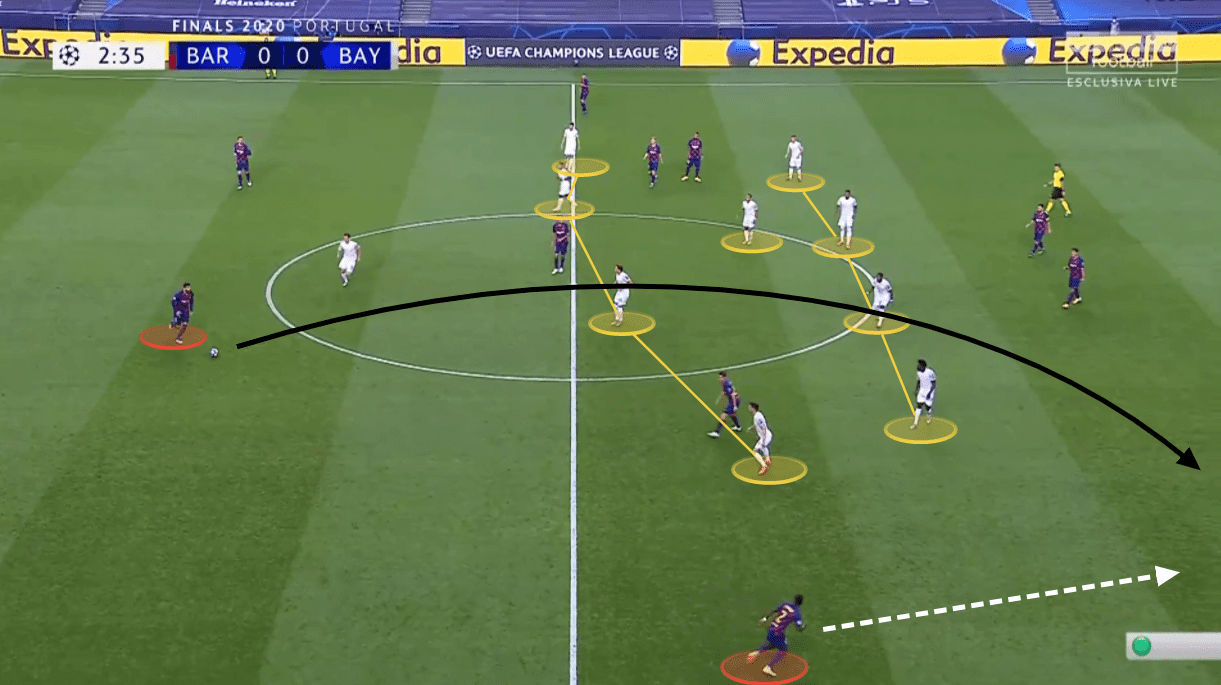
Two reasons Pique could find Semedo with so much space. One – Bayern opted for a 4-1-4-1 or a 4-2-3-1 structure depending on the dynamics of the game. Bayern midfielders kept tabs on the Barcelona midfielders but it left Lewandowski to deal with both the Barça centre-backs. It wasn’t always in his hand to press the ball-carrier. It resulted in the centre-backs having the time to pick their preferred pass. Two – Bayern looked to be more inclined towards the right-flank with the intention of preventing the more dangerous Alba on the right flank.
After just four minutes of the above situation, Bayern’s biggest nightmare came true when Lenglet found Alba’s marauding run behind Kimmich and the immediate aftermath resulted in a goal for Barcelona.
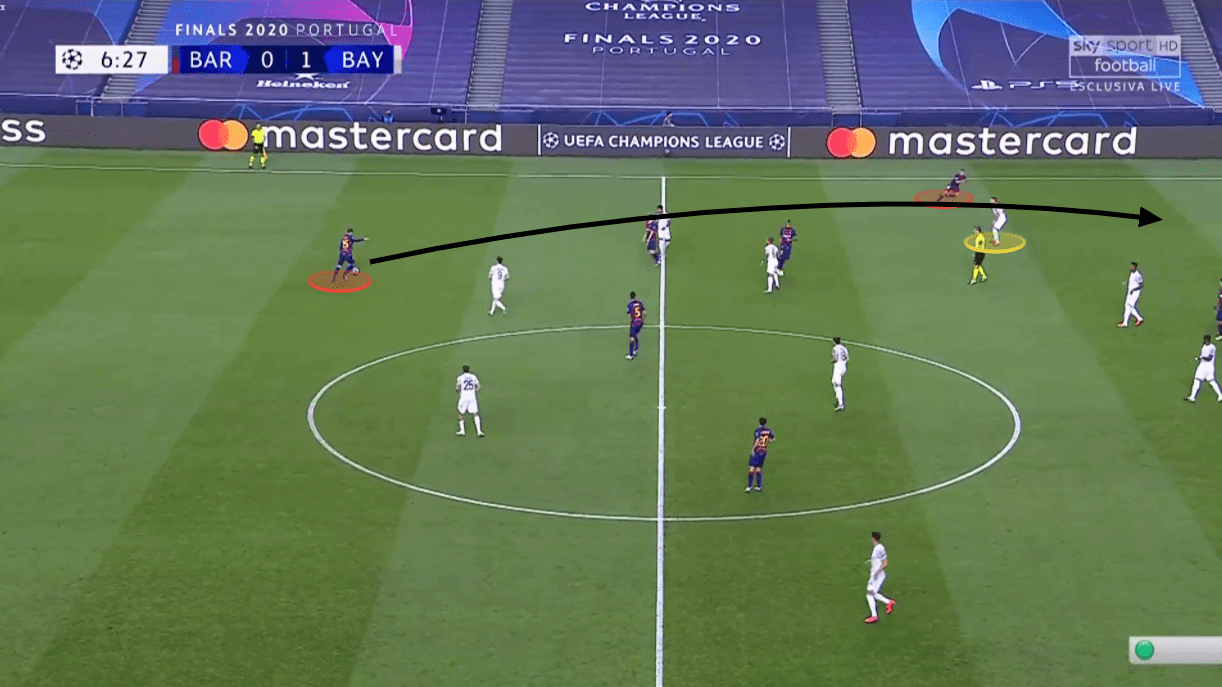
Paradoxical to Kimmich’s game, rather the entire back four’s game, they were caught flat-footed and square-positioned. It resulted in Alba gaining a massive distance over Kimmich.
Barcelona were constantly given such opportunities by Bayern to exploit their flanks, with Lewandowski not always able to press the centre-backs aggressively.
In a similar situation below, Bayern pressed with 4-2-3-1, with the Barcelona midfielders man-marked and Goretzka protecting the defence. Semedo was again left with a huge space on the flank. A pass from Lenglet to Semedo would have surely put Bayern in huge trouble. However, the pass from the French defender was poor and it was easily intercepted.
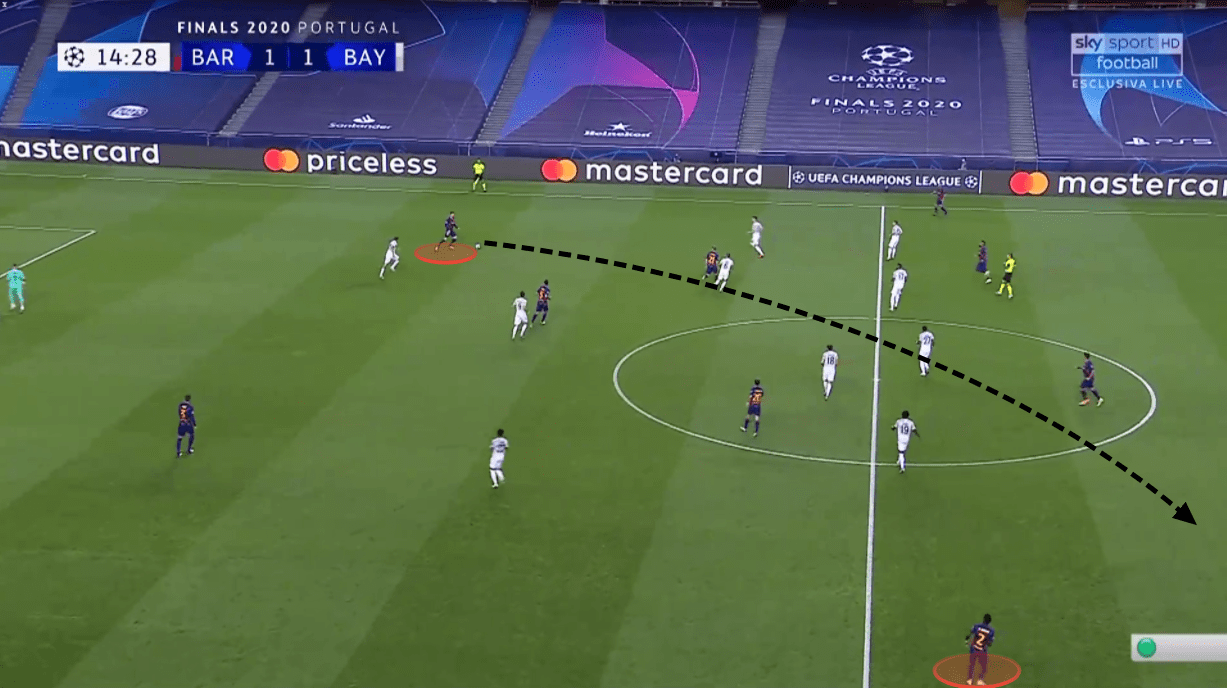
With Lenglet’s lost confidence in switching the play, he opted for shorter passes in the central corridors to progress the play and played into Bayern’s hands.
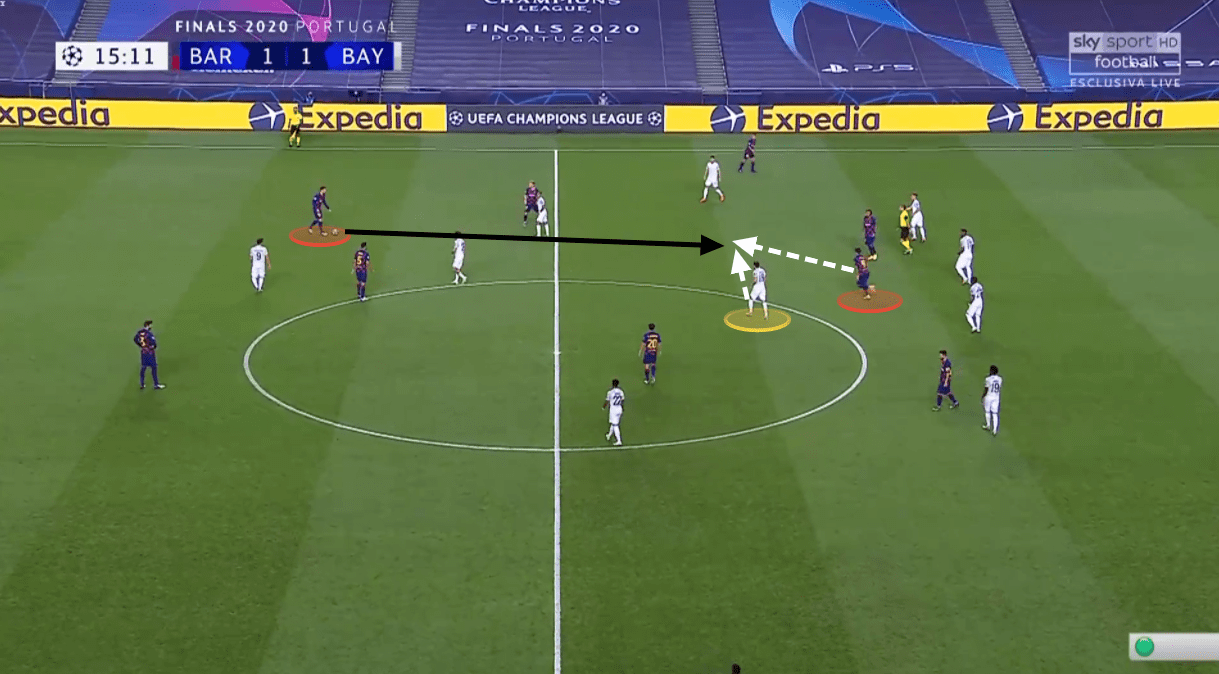
Here, Lenglet opted for a pass to the dropping Suárez and Flick instructed his midfielders to protect the space in between the lines exactly for these kind of play. Bayern soon gained confidence and we all know what happened next.
The part where Barcelona lost the match
Speaking of what happened next, let’s dive deeper into the analysis. Bayern tormented Barcelona with their high press. Marc-André ter Stegen who is so confident and efficient on the ball looked like a puppet to Bayern’s pressing structure. The Bavarians forced ter Stegen to pass where they wanted him to pass and then kill Barcelona’s build-up with several pressing traps. But first and foremost, the Bavarians squeezed Barcelona in the first line of build-up itself forcing the German goalkeeper or the defenders to make errors. ter Stegen who has a passing accuracy of 90.7% and a long pass accuracy of 64.5% in 2019/20, registered 75% passing accuracy and 47% long pass accuracy in this game. This does indicate a certain complication.
In possession, Barcelona looked to play with a 4-3-3 structure instead of the flat 4-4-2 when building out from the goalkeeper.
The initial structure of Bayern when Barça had a goal-kick would be similar to the image below.
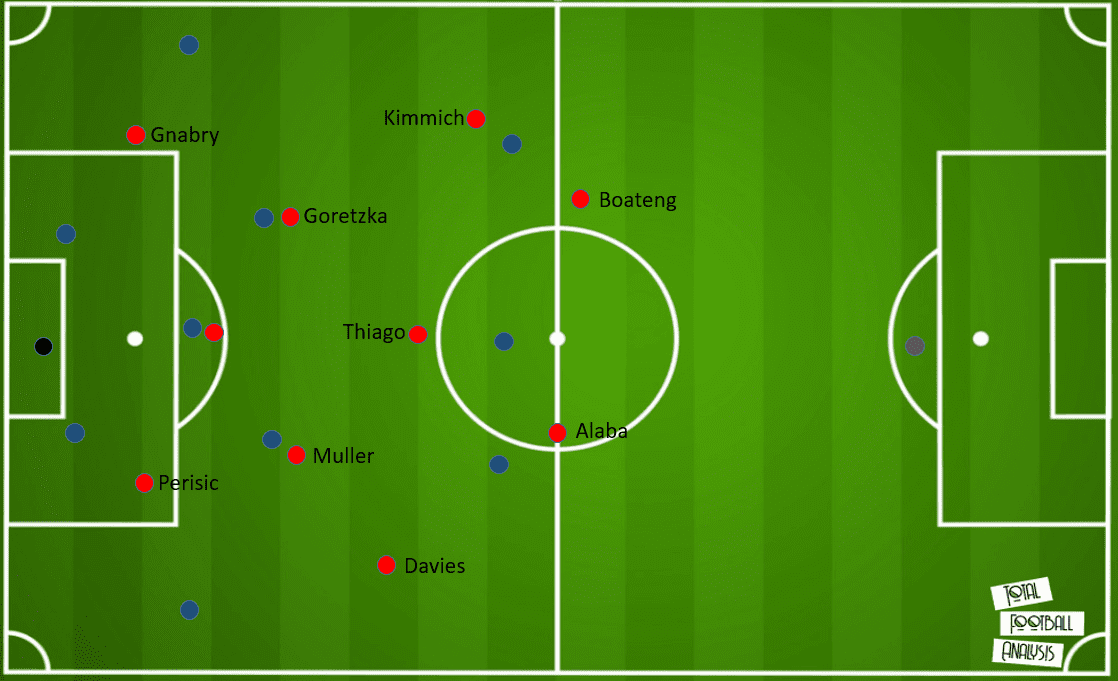
Lewandowski would mark the pivot, Muller and Goretzka would follow the other Barcelona midfielders and Thiago would position himself in front of his defenders to prevent any Barcelona players dropping deep and opening up a passing lane. The wingers had a job of covering two players, centre-back and the full-back in their proximity. The Bayern full-backs would position themselves closer to their last line of defence but can press the Barcelona full-backs if ter Stegen manages to bypass the pressure, with Davies closer to the Barcelona right-back than Kimmich to the left-back. One reason for this can be Alaba’s and Davies’ pace on the left-flank compared to Kimmich and Boateng’s pace on the right. The pressing is triggered when the goalkeeper passes the ball to the centre-back.
A similar in-game structure could be seen in the image below.
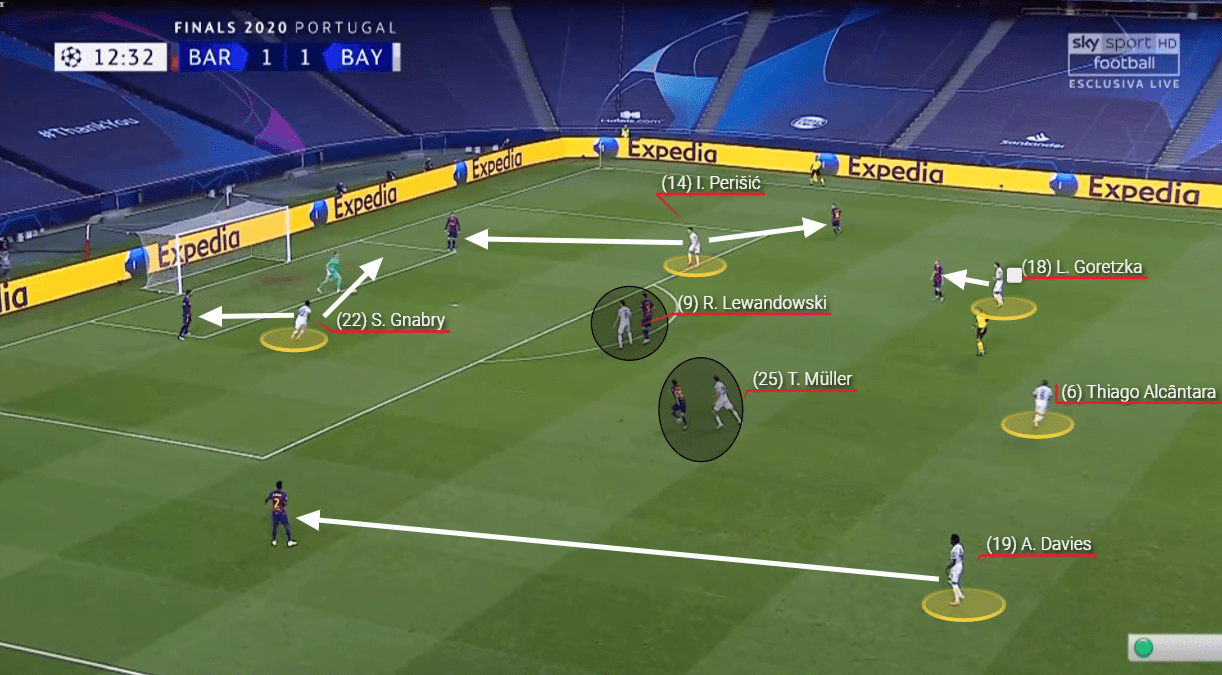
The German goalkeeper passed the ball to Piqué and set Bayern’s pressing trigger. With Gnabry pressing the Spaniard, he passed it back to the German. Gnabry continued his run with an outward to inward movement trying to cover shadow Piqué as well as Semedo to a certain extent. The other players were marked as stated. Davies was in close proximity to Semedo and can press the Portuguese with his pace immediately if ter Stegen opted to loft the ball for the right-back. With no promising options, ter Stegen opted to go long but the pass was intercepted by Thiago.
The press might look like a 4-4-2 diamond but it was the dynamics of the game that made it look like a diamond. The major idea of Flick was to mark the Barcelona midfielders closely and Thiago to cover the dangerous space in front of his defence. We all know when the opposition looks to cut the short passing options, ter Stegen always finds an option in the form of the dropping Suárez or any other attacking players. The German gaffer played a masterstroke with Thiago’s positioning along with other aspects and cut the major passing options of the German goalkeeper.
However, Barça did manage to break Bayern’s press successfully only once and to Bayern’s dismay, it resulted in Barcelona’s second goal. The goal came with a tweak in Barcelona’s formation in the second half. With Antoine Griezmann in place of Roberto, Barça switched to 4-2-1-3 when playing out from the goalkeeper. Bayern looked to have switched off for a moment with the midfielders lost and marking no one in the middle. Lewandowski had both the Barcelona midfielders to take care of, which was impossible. Kimmich moved up but followed Griezmann which left de Jong unmarked. Even though the wingers did their duty, the midfielders let them down.
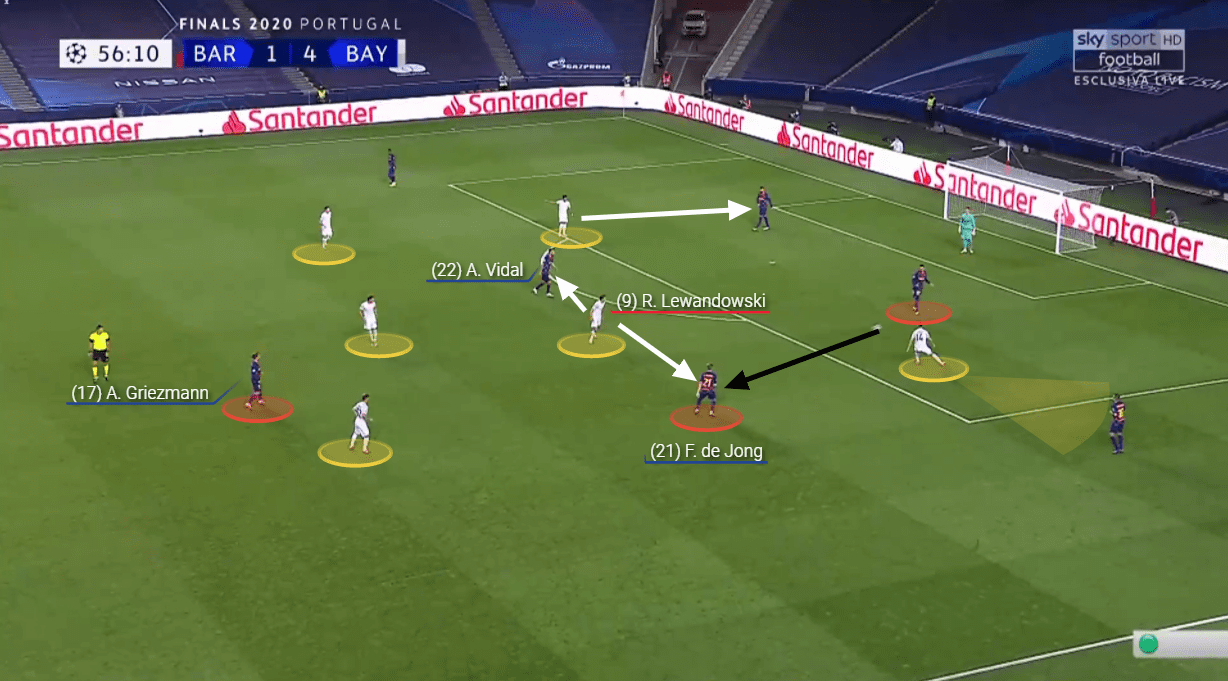
Lenglet’s pass found de Jong and the Dutch midfielder progressed the ball and the aftermath of it resulted in Barcelona’s second goal.
Only once did Barcelona enjoy such success. After conceding the goal, Bayern soon buckled up and devised an easy strategy to mark Barcelona once again.
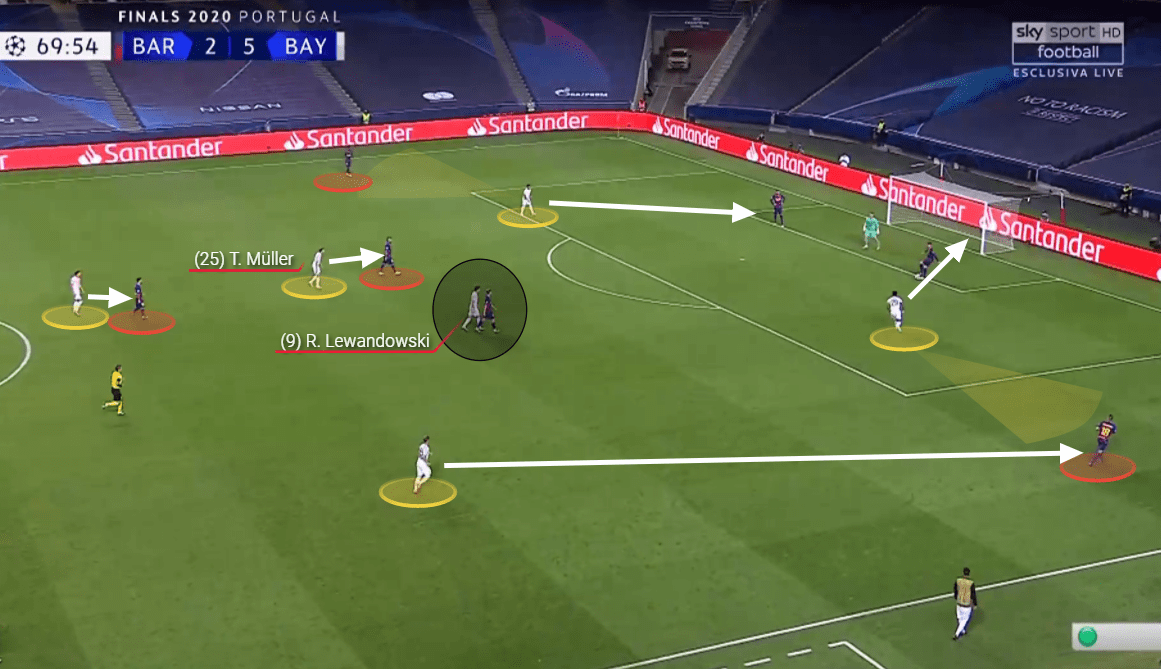
The wingers did their usual duty but Muller and Lewandowski now had the task of marking the double pivot of Barcelona. Goretzka followed the dropping attacking player, in this case, it was Lionel Messi.
The pressing traps
Bayern Munich’s space-orientated pressing creates a lot of opportunities to create a pressing trap on both the flanks as well as the central corridors. Space-orientated pressing is a mix of zonal marking and man-marking. Each player is responsible for covering a zone and man-mark an opposition player in their zone.
The space-orientated pressing does leave the wingers with marking two players in the form of a midfielder and the full-back. Rather Hansi Flick prefers his wingers to position themselves in between the two opposition players but in close proximity to the half space than the full-backs on the flanks in order to trap the opposition in the flanks.
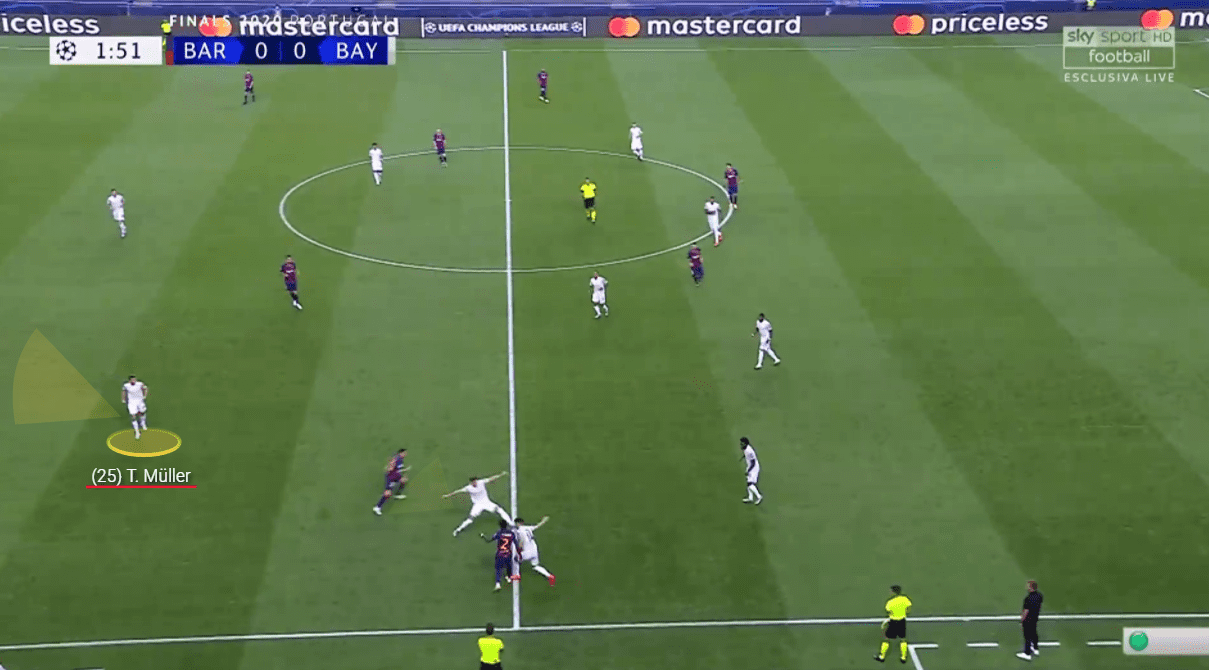
Here, Bayern’s structure forced Barcelona to play out wide. When the ball was forced out wide, Perišić (LW) immediately pressed Semedo (RB) and Goretzka (LCM) looked to cut the immediate passing lane, and Müller cut the passing lane to Piqué (RCB). Semedo had no passing lane to play the ball and Bayern recovered the ball immediately.
Bayern’s pressing structure looks to force the opposition out wide but even if the opposition looks to play through the central corridors, the Bavarian’s pressing mechanism creates a pressing trap in the central corridor too. Hansi Flick has created a monster who torments the opposition with their pressing.
As previously mentioned, Bayern wingers positions themselves in a close proximity to the half spaces rather than the flanks. It helps them to create a pressing trap in the central corridors.
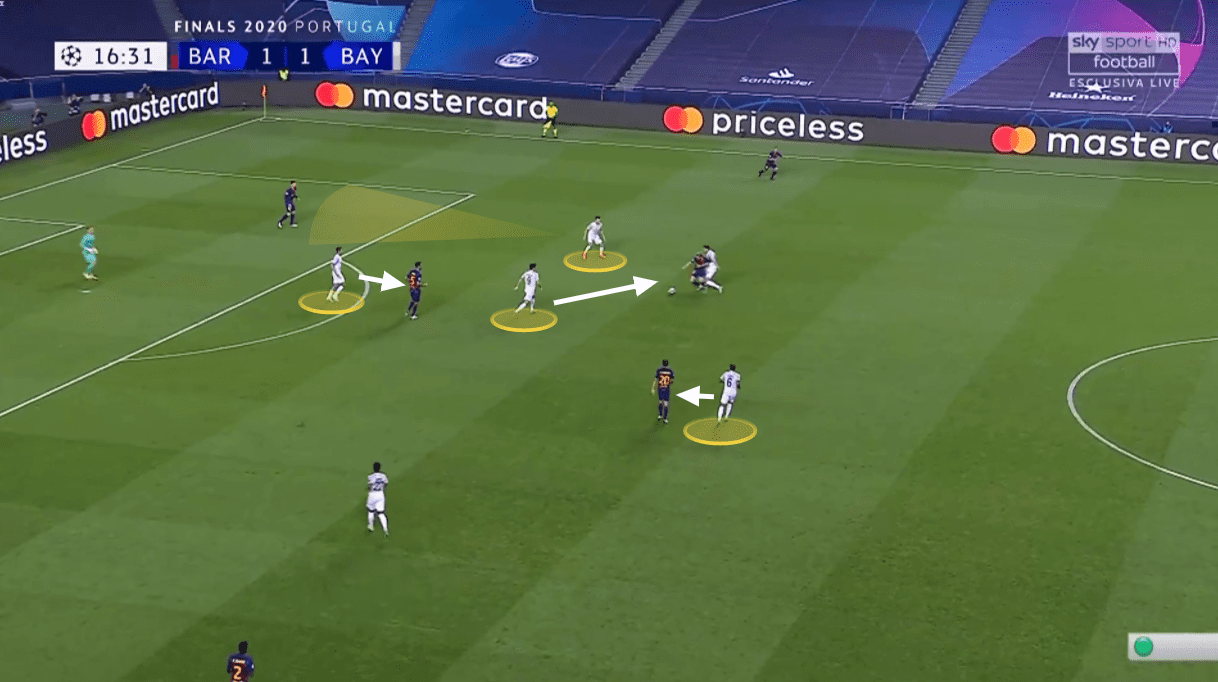
Here, ter Stegen found a passing lane in the form of de Jong. Once de Jong receives the ball, Goretzka pounces onto him. Lewandowski joins the press to help out his fellow teammate. Perišić (RW) cuts the passing lane to Lenglet (LCB). Thiago cuts the passing lane to Roberto. Goretzka’s aggressive pressing and the body orientation in pressing makes it difficult for the Dutch midfielder to turn away and pass the ball to Alba on the flank. It results in a Barcelona turnover.
Even when the opposition looks to have found the method to bypass the trap due to their intelligent movement or Bayern’s susceptibility in the structure in a certain phase, the Bavarians turn the disadvantage into an advantage.
Here, Bayern were caught in their poor pressing structure. Müller now had two midfielders to cover in Busquets and de Jong. The Raumdeuter intentionally opened up the passing lane to de Jong and blocked the passing lane to the Spanish midfielder. The German was well aware of Perišić’s positioning and recognised the idea of creating a better trap if the ball was played to the Dutch midfielder.
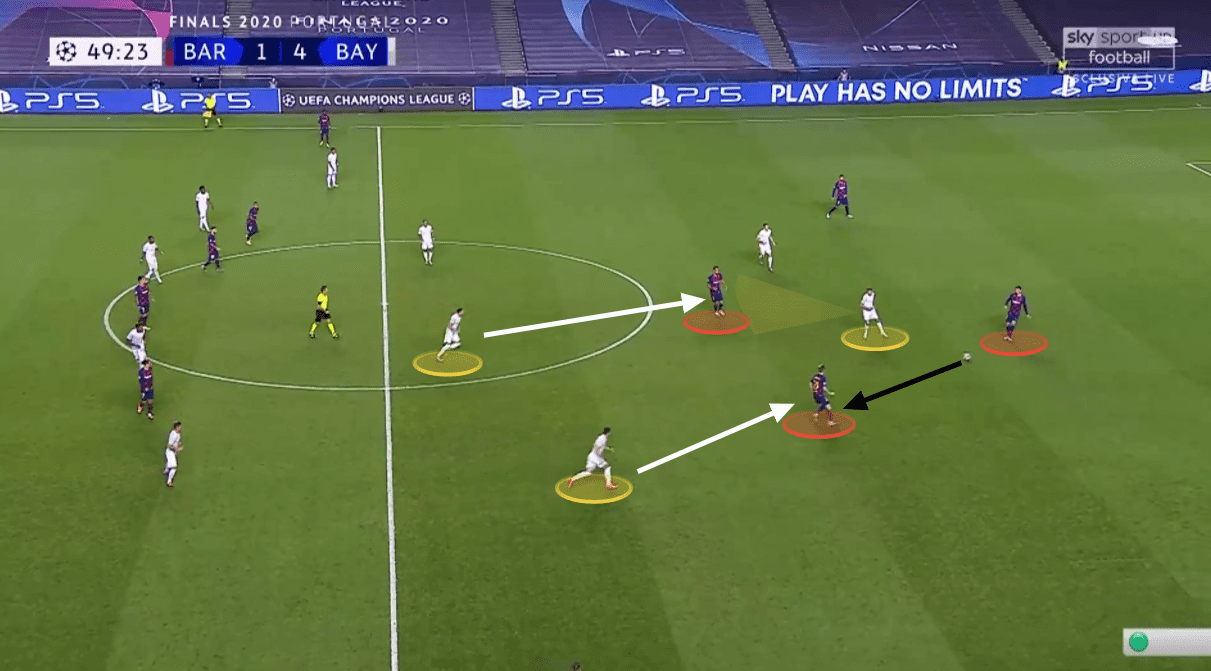
Once the ball was played to de Jong, Perišić made an outward to inward movement blocking the passing lane to Alba. Goretzka immediately marked Busquets and the two strikers partially blocked the passing lane to the centre-backs. De Jong had no option but to play the ball to Griezmann. Boateng’s aggressive press bothered the French attacker and it resulted in a turnover.
The contrast in rest defence
There was no beating Bayern on that day and the Bavarians had mastered the art of pressing. However, Barcelona did not only lose Bayern to their exquisite pressing rather lost to the German team in each and every department. There was a stark contrast in the structure of both the teams, which is even more visible in both the team’s rest defence.
Bayern and Barcelona both overloaded the last line of defence but the structure of Bayern was such that once the Bavarians lost the ball, they overloaded the Barcelona ball-carrier with numbers immediately whereas when Barcelona lost the ball, even then Bayern overloaded them with numbers. It prompted one team to counter-attack and another team to lose the ball.
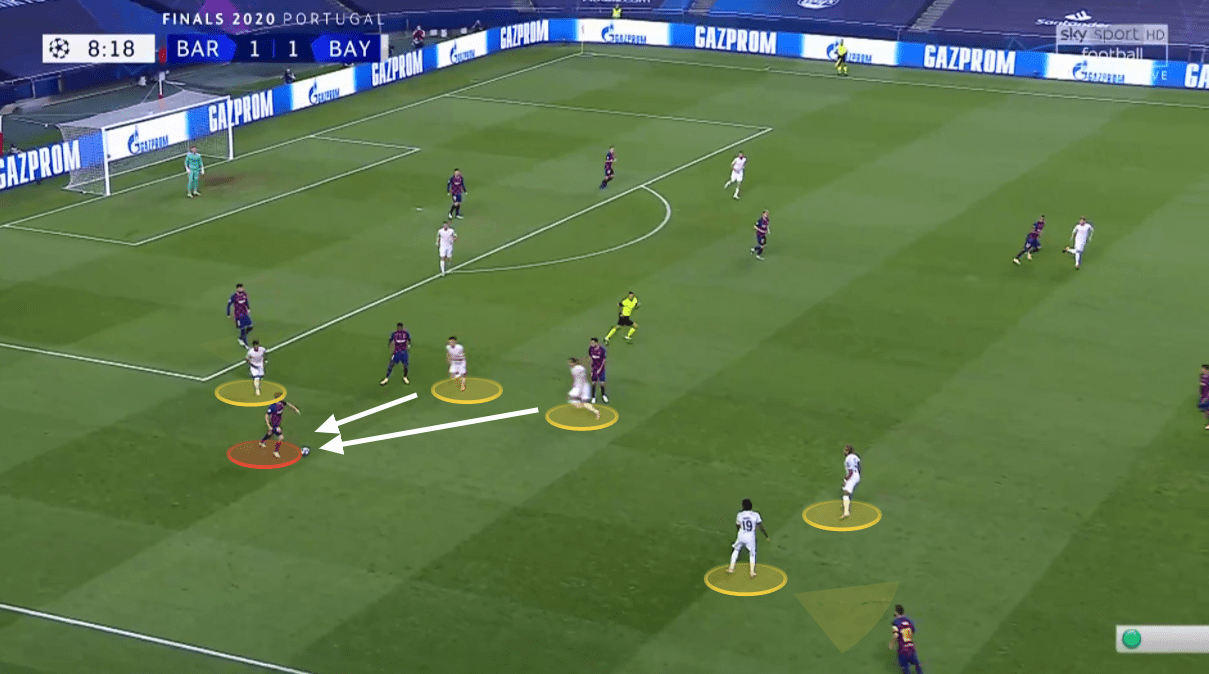
Here, Gnabry lost the ball. Once the German winger lost the ball, the Bavarians hunted the Barcelona ball-carrier in packs. Goretzka and Perišić pounced on Roberto and the other players cut the passing lanes.
The situation below best describes Bayern’s aggression and efficiency in their pressing and counterpressing. It did not matter whether Bayern were 5-2 up or they lost the ball inside the 18-yard box.
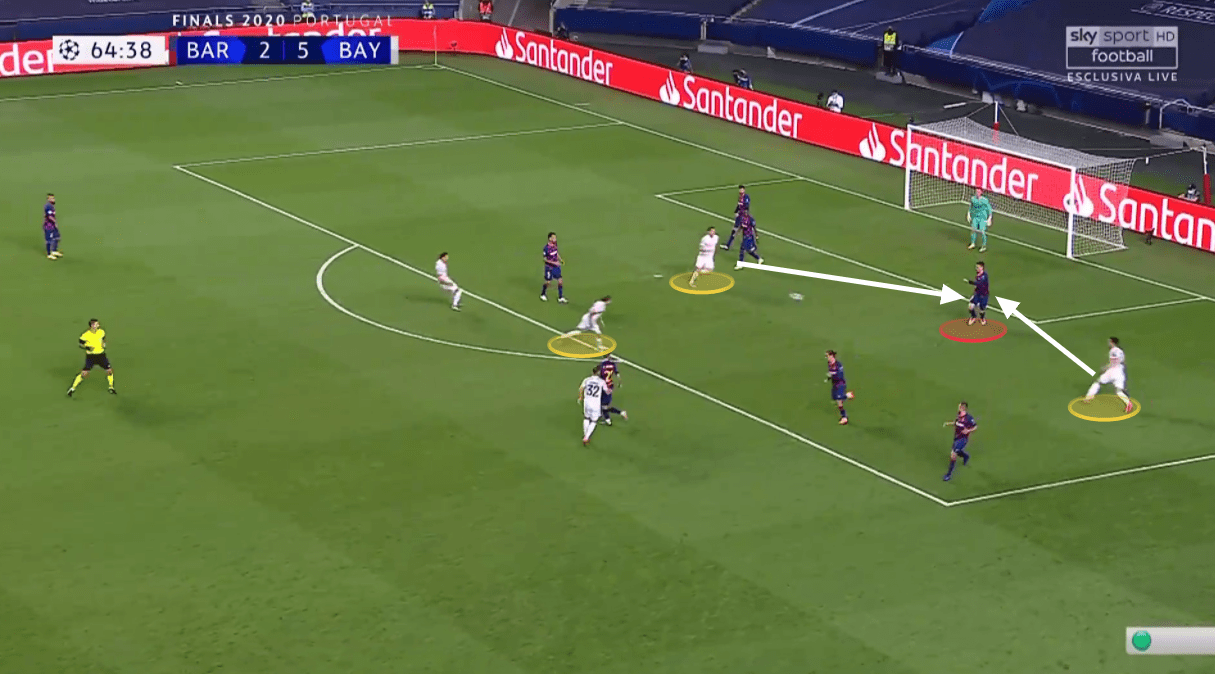
Here, Perišić’s cross was intercepted by a Barcelona player. Once he played a short pass to his teammate, two Bayern players immediately look to pounce on him and other players looked to cut the passing lanes.
The performance of Bayern was reminiscent of Borussia Dortmund under Jürgen Klopp who popularised ‘gegenpressing’ another name for aggressive counterpressing.
When we look at Barcelona’s counterpress, there is a stark contrast. The Barcelona players are so dispersed, it’s impossible for them to counterpress with numbers.
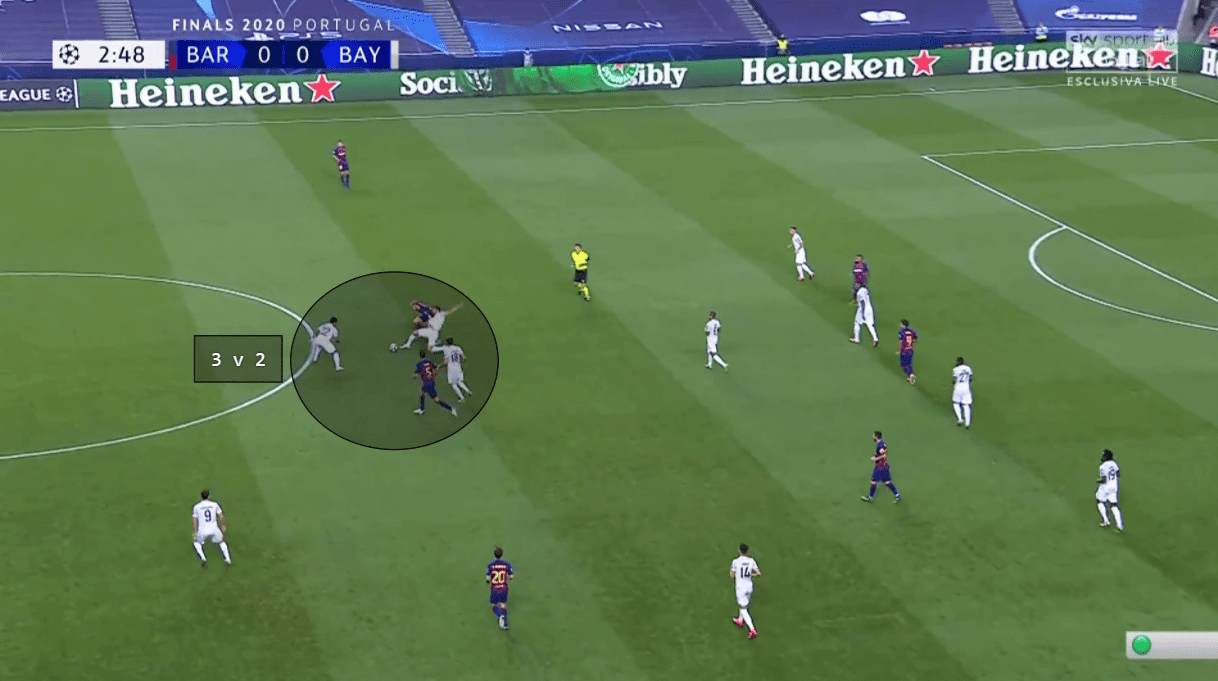
In this case, Bayern had a 3 v 2 overload on the two Barcelona midfielders. Once Bayern won back the ball, the Bavarians started the counterattack through Gnabry and opened their account for the night.
The stark difference is visible in the stats itself, Bayern Munich have recovered 44 times in the final third and the middle third whereas Barcelona recovered a mere 21.
Conclusion
Barcelona had no answer to Bayern Munich’s press, aggression, and the extensive desire to win. The Bavarians won in all the departments of the game and the scoreline gives a true indication of the performance of both the teams.
This Bayern Munich team has everything and it’s their title to lose. Even if the Bavarians do end up not winning the Champions League, this team and this scoreline will go down in history and everyone will remember the mesmerising football Hansi-Flick’s team produced.





Comments